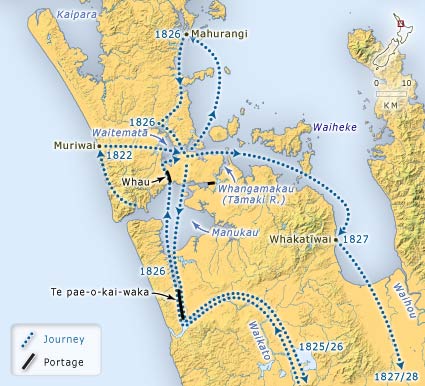
In 1822 the Ngāti Whātua leader Āpihai Te Kawau arrived home from a campaign to find that Ngāpuhi had annihilated many Tāmaki settlements. Fearing further Ngāpuhi attacks, he and his people retreated to Ōneonenui pā, near Muriwai. By summer they felt sufficiently secure to return to Tāmaki, settling at Te Rehu (Westmere). Following the Te-Ika-a-ranganui battle in 1825, Te Kawau sought shelter in Waikato. In the winter of 1826 Ngāti Whātua moved north to Mahurangi, where they were made welcome by Ngāpuhi relatives but subjected to a series of attacks by hostile northern tribes. These forced them to retreat to Kopupaka, near Whenuapai, from where Te Kawau accepted the protection of Ngāti Paoa at Whakatīwai in 1827. Still feeling unsafe, the sub-tribe sought greater security in Waikato, settling at Te Horo, by the Waipā River, in 1831. Te Kawau’s people returned to Tāmaki later in the decade.
Using this item
Te Ara - The Encyclopedia of New Zealand
This item has been provided for private study purposes (such as school projects, family and local history research) and any published reproduction (print or electronic) may infringe copyright law. It is the responsibility of the user of any material to obtain clearance from the copyright holder.






Add new comment